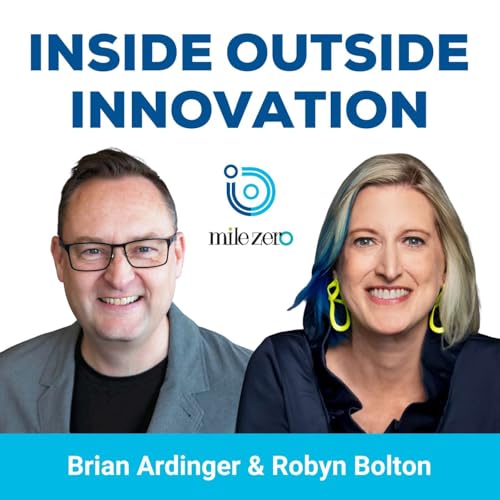On this week's episode of Inside Outside Innovation, Robyn and Brian sit down to talk about divergent thinking, peak college towns, and how as little as 250 documents can poison your AI. Let's get started.Inside Outside Innovation is the podcast to help innovation leaders navigate what's next. Each week, we'll give you a front row seat into what it takes to grow and thrive in a world of hyper-uncertainty and accelerating change. Join me, Brian Ardinger, and Miles Zero's Robyn Bolton as we discuss the latest tools, tactics, and trends for creating innovations with impact. Let's get started.[00:00:40] Brian Ardinger: Welcome to another episode of Inside Outside Innovation. I'm your host, Brian Ardinger, and I have my co-host, Robyn Bolton. Hello, Robyn.[00:00:47] Robyn Bolton: Hello, Brian. How are you today?[00:00:49] Brian Ardinger: I am doing well. Episode 338. We're excited to talk about innovation. I'm so glad you're on the journey with me here. [00:00:56] Robyn Bolton: Wow. 338. There should be a cake or streamers or something. [00:01:01] Brian Ardinger: Well, as usual, we've got a number of different articles and things that have caught our attention over the last couple days. So, I figure we'd dive in. And the first article I wanted to talk about today was for my friend Audrey Crane. She works at Design Map, and she posted on the Design Map blog an article on Divergent thinking.The article, I'll give it a little preface. So, it was looking at how you generate better ideas. Looked at a lot of things. First of all, looked at the research and the fact that there's a famous study by George Land and Beth Jarman looking at how five-year-olds were asked to come up with as many uses as possible for a paperclip, and nearly all of them, 98% could generate 200 or more ideas.They continued to do this study and looked into adulthood, and by the time the participants became adults, only 2%. Of adults could actually do the same thing and generate 200 ideas about a paperclip. It's pretty crazy, and it points to the fact that, while it's a super important skill to have, to be able to generate new ideas and think about different things. We are losing that ability as we get older. [00:02:08] Robyn Bolton: It was surprising and sad, but reminded me of two things. So, one is a book that came out a long time over a decade ago now, the Innovator's DNA. Where the authors looked at, you know, across hundreds, thousands of successful, both entrepreneurs and intrapreneurs, corporate innovators.And they found that the one thing that they had in common, or most had in common, was associative thinking, which. Is being able to put two very different ideas together to make something. And so divergent thinking actually reminded me a lot of the associative thinking. Because it just, your brain works in different ways.And the second thing is, you know, I teach at Massachusetts College of Art and Design, and in talking to my actual art colleagues there, one of the things that they say that's very consistent with what we say in innovation, is that your first idea, your first work, your first version is always the worst.They have different language around the idea of constraints and don't accept the first version, but that is a very common discipline within the art and design world. That it's just your first idea is going to be terrible, so you've got to push past it. And that was another aspect of this article that I found really interesting.[00:03:29] Brian Ardinger: It fits into startups as well. I was mentoring the new batch of NMotion companies are going to be announced here soon that are going through it. And did a little round table and met each of the teams and talked about what they're building and that. And the piece of advice I left them with is, you are here on day one with your idea. Be open to other ideas that happen when you start talking to customers and trying to understand if, if you really are onto something.Because a lot of times you get into an accelerator or you get some early traction and you think, okay, I've got all figured out. I got the solution. I'm just going to barge ahead. But you have to be open to that divergent thinking and different ways of doing things just so you don't necessarily leave opportunity on the table. [00:04:08] Robyn Bolton: It's the old adage, right? The fall in love with the problem, not the solution. And it's so easy to fall in love with the solution, but the divergent thinking article was a great reminder. Data-based reminder of why we've got to nurture the skill to go beyond that. [00:04:26] Brian Ardinger: Yeah, and I love the article too, because Audrey goes into a number of different techniques, brainstorming techniques, and that. Mm-hmm. So, I encourage people to check that out, to learn some tactical things about how you go about building up that divergent thinking muscle.The second article, this one made me a little nervous. It's from the Neuron Daily, which is a ...
Show More
Show Less
 Dec 9 202515 mins
Dec 9 202515 mins Dec 2 202514 mins
Dec 2 202514 mins Nov 25 202517 mins
Nov 25 202517 mins 15 mins
15 mins 16 mins
16 mins 18 mins
18 mins 18 mins
18 mins 23 mins
23 mins

